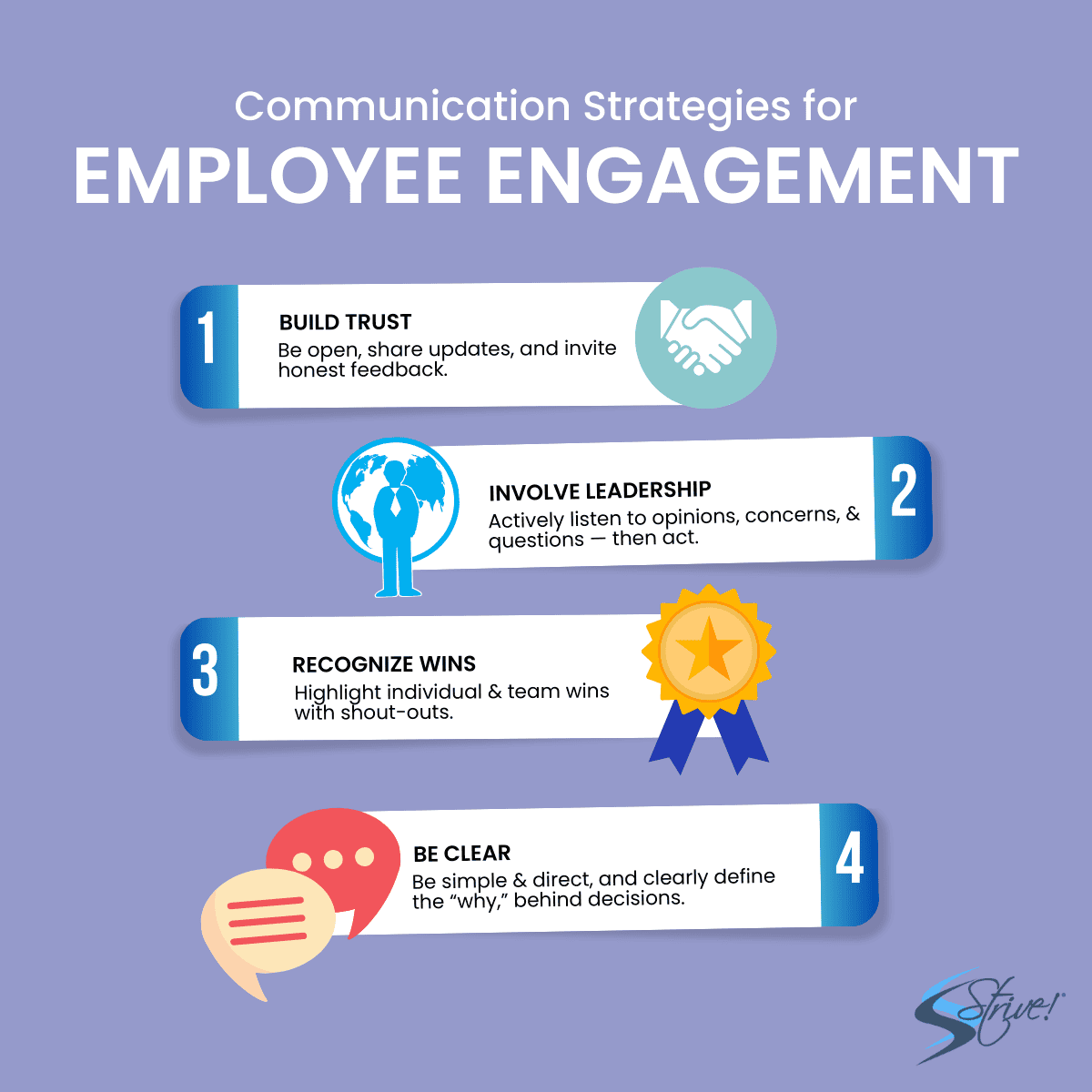Top Strategies for Employee Engagement
Behavioral Science, Communication, & Social ConnectionPicture this: it’s Monday morning and your team logs in for the week ahead. Some are energized and ready to jump in, while others are quietly disengaged. They scroll through emails, counting down the minutes.
This gap is costly. In fact, disengaged employees cost U.S. companies $450–550 billion annually.
So, how do you develop an employee engagement strategy that works? It’s more than free coffee or tshirts. It’s built through intentional strategies: communication that makes people feel heard, social connections that create belonging, and even behavioral science cues that drive real change. Let’s explore the best employee engagement strategies to help leaders shape how people feel and act at work.
Best Employee Engagement Strategies
In this post:
1. How to Develop an Employee Engagement Strategy
2. The Role of Behavioral Science in Employee Engagement Strategy
3. Communication Strategies for Employee Engagement
4. Top Strategies for Social Connection & Community Building
5. Common Challenges & How to Overcome Them
How to Develop an Employee Engagement Strategy (In a Nutshell)
Develop an employee engagement strategy by assessing current engagement levels, identifying key drivers, setting clear goals, and involving leadership. Implement initiatives around communication, recognition, growth, and social connection. Continuously measure results with surveys and feedback, then adjust programs to sustain engagement and align with employee needs.
The Role of Behavioral Science in Employee Engagement Strategy
Employee engagement isn’t just about whether people “like” their jobs. It has three sides: emotional (how connected employees feel to their work and purpose), behavioral (the effort they put in), and cognitive (their belief in the organization and its future). Behavioral science helps leaders turn these ideas into action by focusing on visible behaviors — like collaboration, problem-solving, or sharing ideas — and reinforcing them consistently.
Why Behavioral Science Matters
- Defines what “engaged behavior” looks like. Instead of vague goals, it identifies specific actions you want from employees (e.g., owning problems, proactively improving processes) so they can be measured and supported.
- Focuses on reinforcing positive behaviors. Recognition and encouragement drive lasting engagement far better than punishment or surveillance.
- Bridges the perception gap. Leaders often believe their workforce is much more engaged than employees report. Behavioral surveys reveal the real picture and show where to improve.
5 Behavioral Science Strategies for Employee Engagement
- Celebrate wins — big and small, work, or non-work. Consistent recognition and positive feedback motivate employees more than fear or pressure.
- Close the loop. Pulse surveys and check-ins create feedback cycles that prove leaders are listening and acting.
- Model engagement. When peers and managers demonstrate engaged behavior, others are more likely to follow.
- Use simple nudges. Default opt-ins for programs like wellness or mentoring boost participation without added effort.
- Build trust. Encouraging autonomy and psychological safety creates sustainable engagement built on confidence, not control.
Communication Strategies for Employee Engagement
Communication is at the heart of employee engagement. When messages are clear, consistent, and backed by action, employees feel informed, valued, and connected.
Build Trust
Trust grows when leaders communicate openly and follow through on their promises. Share updates transparently, even when (especially when) the news is tough, and invite honest feedback. Employees are more engaged when information is accurate and leaders are dependable.
Involve Leadership
Engagement starts at the top. Visible, approachable leaders who communicate directly with employees — through town halls, Q&As, or regular updates — help build alignment and credibility. When leaders actively listen to opinions, concerns, and questions, it sets the tone for the entire organization.
Recognize Wins
Highlighting individual and team achievements reinforces positive behaviors and keeps motivation high. A quick shout-out in a meeting or company channel can go a long way toward making employees feel seen and appreciated.
Be Clear
Keep communication simple and direct. Clearly define expectations, explain the “why” behind decisions, and ensure everyone understands their role in the bigger picture.

Top Strategies for Social Connection & Community Building
Research shows that employees with close relationships on the job report higher belonging, lower stress, and better performance. Building community helps teams collaborate more effectively and boosts overall engagement.
Especially among remote teams, employees can feel lonely. This disconnection kills productivity, while on the other hand, a culture of belonging drives loyalty and motivation.
5 Social Connection Strategies for Onsite Teams
- Peer recognition walls or shout-outs. Encourage employees to recognize one another publicly.
- Team lunches and events. Host potlucks, birthday gatherings, chair massage, bowling nights, etc.
- Employee Resource Groups (ERGs). Provide safe spaces for shared identities and interests.
- Volunteer days. Organize group service projects to build pride and purpose.
- Wellness initiatives. Create opportunities for departments to partner on wellness or fitness initiatives (fitness classes, running a 5k).
5 Social Connection Strategies for Hybrid & Remote Teams
- Virtual coffee chats or happy hours. Casual spaces for employees to connect beyond work.
- Default calendar invites. Make joining optional social events seamless.
- Regular office hours with managers. Sessions where employees can stay connected with leadership.
- Digital channels. Make the most of digital tools with designated channels for recognition/gratitude, non-work life updates, hobbies, or pets.
- Team challenges. Wellness, fitness, learning, or volunteer challenges that span locations.
Common Challenges & How to Overcome Them
Low-Budget or Limited Resources
Engagement initiatives can be feasible. Small, consistent actions like group walks, peer recognition, or fun spirit days have a greater impact than a flashy event that happens once a year.
Remote, Hybrid, or Frontline Teams
If you’re geographically dispersed or work out in the field, it can be hard to feel connected to communication or social initiatives. Help employees share in the culture with mobile-friendly tools, digital communication, and inclusive timing for gatherings or events.
Communication Fatigue
Too many initiatives can be overwhelming. Stick to a consistent weekly or monthly cadence to build trust without adding noise. Centralize updates and use clear channels so employees know what to expect and don’t simply scroll past you (quality over quantity).
Resistance from Leaders or Cultural Barriers
Some leaders have a scarcity of time; others are hesitant to change long-standing policies. Shift their resistance to support by starting small, highlighting quick wins, and sharing participation data where possible. Leaders set the tone for engagement, so it’s essential to get their buy-in.
Ensuring Inclusivity
Engagement strategies are not one-size-fits-all. Use surveys and direct feedback to learn what resonates across different groups. Offer varied activities — social, learning, wellness — so employees can engage in ways that feel authentic and growth-oriented.
Implementation Roadmap for HR & Workplace Experience Leaders
1. Assess the Current State
Use surveys, focus groups, and performance data to understand how engaged employees feel today. Identify the emotional, cognitive, and behavioral drivers most relevant to your workforce.
2. Set SMART Goals
Translate insights into specific, measurable goals — such as improving recognition participation by 20% or reducing turnover in a key department.
3. Prioritize Initiatives
Not every idea can be launched at once. Rank initiatives by impact and feasibility, focusing first on strategies that address the most pressing engagement gaps.
4. Secure Leadership Buy-In
Share evidence that engagement drives retention, performance, and well-being. Involve middle managers early; their daily actions often make or break engagement efforts.
5. Pilot and Iterate
Start with small pilots, gather employee feedback, and refine. Scaling proven successes builds momentum and minimizes wasted resources.
6. Measure and Adjust
Track KPIs such as turnover, absenteeism, survey scores, and participation in programs. Use pulse surveys and feedback loops to stay responsive and continuously improve.
Strive Helps Drive Employee Engagement
Strive loves to collaborate with clients on their employee engagement initiatives. From Employee Appreciation Events and incentive management to full-blown wellness programs with weekly programming, our insights come from actual employee feedback.
Book a discovery call today to see how wellness improves your employee engagement strategy.
FAQs
What is an employee engagement strategy?
It’s a structured plan that improves how employees feel, think, and act at work by focusing on motivation, communication, recognition, and connection.
Why is employee engagement important?
Engaged employees are more productive, loyal, and innovative. Strong engagement also reduces turnover and improves overall workplace culture.
How do you measure employee engagement?
Common tools include surveys, pulse checks, retention rates, performance data, and participation in engagement programs.
What role does leadership play in engagement?
Leaders set the tone by modeling engagement, supporting initiatives, and showing recognition. Without leadership buy-in, engagement initiatives often fail.
What are examples of employee engagement strategies?
Recognition programs, wellness initiatives, professional development, social connection opportunities, and clear communication are among the most effective.
How can HR improve employee engagement with limited resources?
Focus on low-cost strategies like peer recognition, manager shout-outs, and feedback loops. Small, consistent actions build trust and connection.
How does behavioral science help employee engagement?
Behavioral science guides leaders to reinforce positive actions, use feedback effectively, and apply nudges, like default participation, to build lasting habits.
What are common challenges in engagement initiatives?
Low budgets, dispersed teams, communication fatigue, resistance from leaders, and ensuring inclusivity are frequent obstacles.




